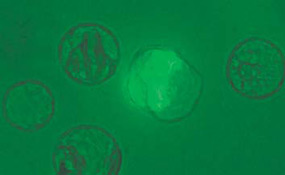| 2005 |

|
YEAR BOOK |
National University of Ireland, Maynooth
|
Plastid engineering: harnessing the chloroplast for fundamental and applied research
|
The chloroplast genome (plastome) is now widely recognised as a favoured alternative to the nucleus for the production of valuable recombinant proteins in plants. It also provides exciting opportunities for exploring chloroplast function and dissecting the complex interplay between nuclear and organellar genomes. The numerous advantages of the plastome include the extremely high levels of recombinant protein that can be produced (due to gene amplification), genetic containment due to the absence of pollen transmission, and precision engineering through targeted integration at any chosen point on the genome. The team at NUI Maynooth was at the vanguard of development of plastid transformation technology for the model plant (tobacco), and has recently been instrumental in extending the capability to other crops (potato, tomato, cauliflower).
A critical mass of researchers has been generated through a succession of research awards. A high profile application of the technology is in the area of pharmaceutical production, developing the plastid for the production of vaccines against HIV, TB and diabetes, as part of a major EU initiative. A Science Foundation Ireland investigator award underpins "Health and Industry" applications of plants through an investigation into the complex biosynthesis, composition, and turnover, of starch in chloroplasts (in leaves) and amyloplasts (in tubers). This will provide valuable information on the regulation of starch metabolism and could lead to strategies for modifying both quality and content of starch in plants. The grant also allows us to explore several strategies for enhancing the nutritional properties of leafy crops through increased production of sulphur-containing amino acids.

|
|
Contact: Prof. Phil Dix, Department of Biology,
National University of Ireland Maynooth,
Maynooth, Co. Kildare, Ireland;
E-mail: [email protected]